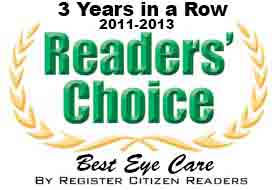Eye Conditions
When questioned why my new patients left their last eye doctor, most of the time one of the reasons is that their previous doctor did not take the time to thoroughly explain the findings of the exam. At Torrington Eyecare we take pride in explaining in detail any abnormalities discovered during your exam. With that being said, we have decided to put together a list of common eye conditions and definitions so our patients can be well informed before coming to the office before their exam.
Myopia: Also known as near sightedness. Myopia arises when the eyeball is longer than average, resulting in blurry vision in the distance. We use prescription contacts and eyeglasses to allow for clear vision.
Hyperopia: Also known as far sightedness. Hyperopia arises when the eyeball is shorter than average, resulting in blurry vision up close. Many times a patient can be hyperopic and not know it since the eyeball can focus out the blur prior to reaching presbyopia.
Presbyopia: A weakening in the muscles of the eye which results in blur when trying to read. Presbyopia typically begins around age 40 and continues to progress through age 65. It can be treated with reading glasses, bifocals, contact lenses, or progressive no line bifocals.
Astigmatism: Abnormal curvature of the front part of the eye (cornea) resulting in blurry vision far away and up close. Some doctors will also say that astigmatism means your cornea is shaped like a football instead of a basketball. With new technology we can treat mild to moderate astigmatism with soft contact lenses. In the past only glasses and hard contacts were adequate.
Glaucoma: Although there are numerous causes of glaucoma, the end product of any untreated glaucoma is loss of side vision due to increased pressure inside the eye. There are no signs or symptoms of glaucoma until it is too late. Annual eye exams are essential to ensure early detection and proper treatment of glaucoma. Most forms of glaucoma are treated with eye drops.
Cataracts: Cloudiness of the lens inside the eyeball resulting in blur, glare, and lack of light. Cataracts typically begin in your mid 50’s and require surgical removal in your 70’s. UV light from the sun plays an important role in cataract development. Wearing a prescription pair of sunglasses can help prolong the maturing of cataracts.
Macular Degeneration: Also known as age related macular degeneration or ARMD. Macular Degeneration is a deterioration of the central retina. There are two forms of AMD, dry and wet. Initial symptoms of both are typically decreased vision, blur, or seeing straight lines as wavy or distorted. Dry macular degeneration is more common, less severe, and tends to decrease central vision over time. Wet macular degeneration tends to be more abrupt and typically leads to moderate to severe central vision loss. Early detection of dry macular degeneration and intervention with supplement therapy can help stop the progression to wet AMD.

